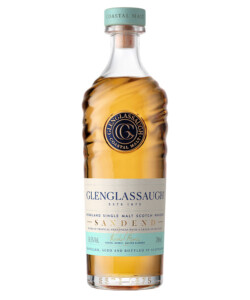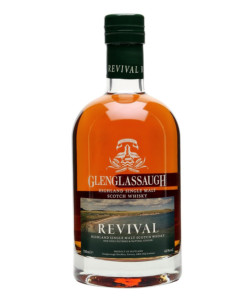Nestled along the coast of northern Scotland is Glenglassaugh, a distillery that dates all the way back to 1875. Originally established by local entrepreneur James Moir, his nephews Alexander and William Morrison, and coppersmith Thomas Wilson, Glenglassaugh quickly garnered a reputation for producing high-quality whisky. But while the distillery has existed for almost a century and a half, it’s only been fully operational for a combined 70 of those years.
Despite periods of instability on the evolving Scotch market, Glenglassaugh has remarkably clung to life, and was revamped in 2023 with a completely new portfolio. Currently owned by Brown-Forman and marketed as a coastal single malt distillery, Glenglassaugh is synonymous with robust yet fruity whiskies, all carrying a salty undercurrent from time spent maturing next to the sea.
Now that you know the basics, here are eight more things you should know about Glenglassaugh, one of the whisky world’s most resilient phoenixes.
-
The location of the distillery was chosen for its close proximity to natural resources.
Access to a quality water source was an important factor for Moir when selecting the location for Glenglassaugh. As such, he chose the original site for its close proximity to the Glassaugh spring, which is located on Durne Hill and overlooks the distillery on the coastline. The spring provides an abundance of hard, mineral-rich water that results in the bigger-bodied, slightly sweet, and fruity whiskies Glenglassaugh is known to produce. The site also grants accessibility to nearby barley fields, which originally supplied the brand with grains necessary for distillation. The decision to open along Sandend Bay is also a nod to Scotland’s illicit spirits manufactures: The region was favored by distillers between the 1760s and 1830s during the illegal Scottish whisky trade.
-
Glenglassaugh is technically a Highland whisky.
Glenglassaugh straddles the dividing line between the Highland and Speyside Scotch classifications, and while the Speyside is technically a subregion of the Highlands, it would be a mistake to conflate the two. As the distillery is located just outside of Portsoy, it may be easy to classify Glenglassaugh as a Speyside single malt producer. Instead, it is technically considered a Highland single malt distillery, as evidenced by its whisky’s round and somewhat harsher flavors as opposed to Speyside’s gentler, honeyed whiskies. While numerous attempts have been made to soften the spirits produced at the distillery over the years, none were successful, and often resulted in less-than-desirable whisky.
-
The distillery was once owned by Highland Distillers.
When Moir and Wilson passed away at the end of the 19th century, ownership of the distillery was turned over to Alexander and William, who equipped the distillery with brand-new washbacks and stills. But when William died in 1892, Alexander was unable to take on the role as sole owner and offloaded the business to spirits broker Robertson & Baxter, which later sold it to Highland Distillers. Most notable for its ownership of cult-followed brands like The Macallan, Highland Distillers transformed the distillery from small-batch production to over 110,000 gallons per year by 1898. That success was short-lived, though, as the distillery was forced to close its doors just 15 years after its acquisition.
-
It was mothballed for over 50 years in the early 20th century…
In 1907, Glenglassaugh was forced to cease operations following a downturn in Scotch whisky’s popularity. Along with the vast majority of other Scotch distilleries, it remained closed through the entirety of World War I and American Prohibition. In 1900, there were approximately 150 functioning distilleries in Scotland, but by the early 1930s, only 15 remained.
The end of Prohibition brought a small resurgence to the Scotch industry in 1933, but it wasn’t enough to return Glenglassaugh to its former glory, and its doors remained shut. This larger Scotch resurgence was also incredibly short-lived, with the outbreak of World War II mandating the closure of distilleries in the U.K. as whisky production was outlawed for rationing purposes. When wartime rationing was dismissed in 1954, it didn’t take long for Scotch distillers to re-establish themselves and the public to regain a thirst for the whisky. Following this uptick in interest, Highland Distillers finally reopened Glenglassaugh in 1960 — 53 years after the distillery was initially closed — with the intention of making a blending whisky in a new production facility.
-
…and again for another 22 years at the end of the century.
While the initial Scotch whisky comeback briefly helped boost Glenglassaugh’s sales, it wasn’t long before the distillery would be mothballed once again. Despite the distilley’s intention to market a blending whiskey, many whisky blenders found the product to be too unique and likely to overtake the flavor profile of their blends. That meant Glenglassaugh had an enormous surplus of single malts it was unable to offload throughout the 1960s and ‘70s. The situation worsened in the ‘80s when the demand for Scotch once again plummeted, resulting in a nationwide surplus known as the infamous Whisky Loch. In 1986, Glenglassaugh was shuttered, and only visited periodically by mash men and warehouse workers tending to existing stock. While many believed the Whisky Loch to be the end of Glenglassaugh, in 2006, Stewart Nickerson — a former distillery manager at William Grant & Sons — started making moves to resume operations at the shuttered distillery. He formed Stewart Galbraith Distillers Ltd (later renamed as The Glenglassaugh Distillery Company), which purchased the distillery on behalf of Russian-financed firm the Scaent Group in 2008. With Nickerson joining the board as managing director, Glenglassaugh ran its first spirit in 22 years through the stills that December. The first whiskies to come from the newly reopened distillery landed on the market just a few months later.
-
After Glenglassaugh’s second reopening, a number of experimental releases followed.
After a two-decade production gap, the team at Glenglassaugh knew they would have to be creative with the spirits they produced upon reopening in order to sustain operations until their Scotch stocks had properly aged. While the brand released some of the stock built up before the 1986 closure, it also started distilling a number of experimental spirits with no age statements, namely The Spirit Drink That Dare Not Speak Its Name and The Spirit Drink That Blushes To Speak Its Name. Both spirits contained a similar mash to Glenglassaugh whisky, though neither was matured in oak for the required amount of time to qualify as Scotch. That meant Glenglassaugh was forbidden from calling the spirits Scotch or even using its own distillery name on the label, hence the cheeky names. The latter expression spent six months aging in red-wine casks, causing it to take on a “blushed” hue.
-
Glenglassaugh completely overhauled its portfolio in 2023.
When Glenglassaugh was able to finally release new whisky after its 2008 reopening, the brand’s core range included Glenglassaugh Revival, Glenglassaugh Evolution, and Glenglassaugh Torfa. But in September 2023, the brand discontinued the three existing whiskies and introduced a brand-new core collection: 12 Years Old, Sandend, and Portsoy. Matured in a combination of bourbon, sherry, and red-wine casks, Glenglassaugh 12 Years Old is bottled at 45 percent ABV and carries aromas of ripe, tropical fruit carried in on a sea breeze. A similar palate follows, defined by notes of vanilla, butterscotch, and oak. It’s so good that VinePair named it the No. 1 Scotch whisky of 2023.
Glenglassaugh Sandend, inspired by the beaches of Sandend Bay, was matured in bourbon, sherry, and manzanilla casks, which the brand says impart aromas of buttery vanilla ice cream, tropical fruit, and sea salt. Bottled at 50.5 percent ABV, the Scotch delivers flavors like salted caramel, pineapple, and cherry. The final offering, Portsoy, is heavily peated and matured in a combination of sherry, bourbon, and port barrels. Bottled at 49.1 percent ABV, the whisky carries strong umami aromas like sherried dark soy and sea kelp along with hints of tropical fruit. According to the brand, its palate highlights notes of charred mango, sea salt, and dark chocolate.
-
The brand’s Serpentine Coastal Cask Collection pays homage to the distilling years lost in the 1900s.
In 2008, the brand discovered a number of rare casks in its coastal warehouses that had continued to age while the distillery was inoperable. Launched in January 2024, the Serpentine Coastal Cask Collection, which consists of three unique single malts each aged in different casks, honors Glenglassaugh’s historical whisky-making and connects its current operation to the past. The youngest of the bunch, Serpentine Coastal Cask #1863, aged for 48 years in Aleatico red wine barrels and is bottled at 46.1 percent ABV. The whisky is said to impart soft blueberry, peach, meringue, and salted pistachio cream aromas followed by a palate of blackberry, lychee, and passion fruit sea salt. Serpentine Coastal Cask #5640 is only slightly older, aged for 49 years in bourbon barrels. According to the brand, the 42.1-percent-ABV whisky carries guava, white peach, and gorse-infused ocean breeze aromas and a palate rich with tropical sun-drenched papaya and passion fruit. The collection’s final offering, Serpentine Coastal Cask #1723, is the oldest of the trio, having matured in oloroso puncheon barrels for a whopping 51 years. The 44.2 percent ABV whisky is said to impart sun-dried raisin, blood orange preserves, sandalwood, and spiced vetiver aromas. A similar palate follows, boasting notes of blackberry jus, salted treacle, and sloe syrup. While no new additions to the line have been officially announced yet, the brand has disclosed that more casks will be added later this year.


